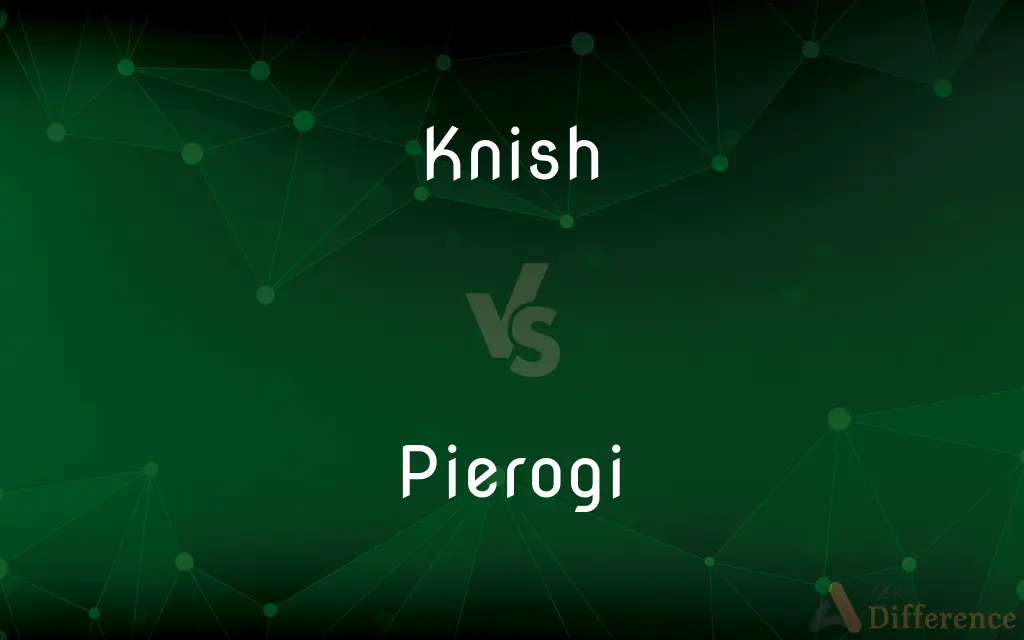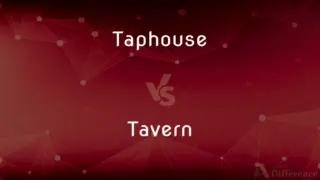Knish vs. Pierogi — What's the Difference?
Edited by Tayyaba Rehman — By Maham Liaqat — Updated on March 31, 2024
Knishes are baked or fried dough pastries filled typically with mashed potato, while pierogi are boiled or fried dumplings of unleavened dough stuffed with various fillings.

Difference Between Knish and Pierogi
Table of Contents
ADVERTISEMENT
Key Differences
Knishes and pierogi represent two distinct culinary traditions. A knish, originating from Eastern European Jewish cuisine, is a savory pastry that is either baked or fried. Pierogi, on the other hand, hail from Eastern European countries such as Poland, Ukraine, and Slovakia.
One of the key differences between knishes and pierogi lies in their preparation and presentation. Knishes are typically larger and meant to be eaten as a standalone snack or side dish, with a doughy exterior encompassing the filling. In contrast, pierogi are smaller, often served in numbers as a main course or side, and their dough is thinner and more tender, designed to encase the moist filling inside tightly.
The dough composition and texture between knishes and pierogi also differ. Knish dough is denser and can be either flaky or soft, depending on whether it is baked or fried. This allows it to hold up to heavier fillings and maintain its shape. Pierogi dough, meanwhile, is softer and more pliable, requiring a delicate balance to ensure it is thin enough to not overpower the filling while still being sturdy enough to not break during boiling.
Culturally, knishes and pierogi have played significant roles in their respective cuisines, serving not only as everyday foods but also as important dishes during festivals and celebrations. Knishes have been embraced in American cuisine, particularly within Jewish communities, as a symbol of heritage and comfort. Pierogi, celebrated through festivals and with a strong presence in traditional Eastern European meals, symbolize home cooking and familial bonds.
Comparison Chart
Origin
Eastern European Jewish cuisine
Eastern European countries (e.g., Poland, Ukraine, Slovakia)
ADVERTISEMENT
Dough Type
Denser, can be flaky or soft, baked or fried
Softer, unleavened, boiled then optionally pan-fried
Typical Fillings
Mashed potatoes, ground meat, onions, cheese
Potatoes, cheese, meat, sauerkraut, fruits
Serving Size & Method
Larger, eaten as a snack or side dish
Smaller, served in numbers as a main or side dish
Cultural Significance
Staple in American Jewish delis, symbol of heritage
Comfort food, present in festivals, symbolizes home cooking
Compare with Definitions
Knish
They have a doughy exterior that can be flaky or soft, enclosing the filling.
The soft, doughy exterior of the knish complemented its hearty potato filling perfectly.
Pierogi
A staple in Eastern European cuisine, often served with sour cream.
In Poland, pierogi are as essential to dining as pasta is in Italy.
Knish
Knishes can be baked or fried, offering a variety of textures.
I prefer my knishes fried for that extra crunch on the outside.
Pierogi
Pierogi are dumplings made from unleavened dough, filled with various ingredients.
We had a mix of cheese and potato pierogi for dinner.
Knish
Often eaten as a standalone snack or side dish.
I ordered a knish as a side to my soup, and it was the perfect pairing.
Pierogi
After boiling, pierogi can be pan-fried for a crispy finish.
My grandmother always pan-fries her pierogi to golden perfection.
Knish
Originating from Eastern European Jewish cuisine, knishes are a popular street food in many cities.
Every Jewish deli in town boasts its unique version of the classic knish.
Pierogi
Considered comfort food, pierogi are enjoyed in both casual and festive settings.
Nothing feels more like home than a plate full of freshly made pierogi.
Knish
A knish is a savory pastry filled with mashed potatoes or meat.
The golden-brown knish smelled amazing, fresh out of the deli oven.
Pierogi
Fillings range from savory to sweet, including potatoes, cheese, and fruits.
The sweet cheese pierogi topped with sour cream were a delightful dessert.
Knish
A knish is a traditional Ashkenazi Jewish snack food consisting of a filling covered with dough that is typically baked or sometimes deep fried. Knishes are often purchased from street vendors in urban areas with a large Jewish population, sometimes at a hot dog stand, or from a butcher shop.
Pierogi
Pierogi ( pih-ROH-ghee) are filled dumplings made by wrapping unleavened dough around a savoury or sweet filling and cooking in boiling water. They are often then pan-fried before serving.
Knish
A piece of dough stuffed with potato, meat, or cheese and baked or fried.
Pierogi
A semicircular dumpling with any of various fillings, such as finely chopped meat or vegetables, that is often sautéed after being boiled.
Knish
An Eastern European Jewish, or Yiddish, snack food consisting of a dumpling covered with a shell of baked or fried dough
Pierogi
(North America) A square- or crescent-shaped dumpling of unleavened dough, stuffed with sauerkraut, cheese, mashed potatoes, cabbage, onion, meat, or any combination of these, or with a fruit filling.
Knish
A fried, or sometimes baked, turnover made from a round or square sheet of dough containing a filling, usually of meat or potatoes.
Knish
(Yiddish) baked or fried turnover filled with potato or meat or cheese; often eaten as a snack
Common Curiosities
What are pierogi?
Pierogi are dumplings made from unleavened dough filled with a variety of ingredients, common in Eastern European countries.
Can knishes be sweet?
While traditionally savory, there are sweet variations of knishes, often filled with fruit or sweet cheese.
What is the traditional cooking method for pierogi?
Pierogi are boiled and can be served as is or pan-fried for additional texture.
Are knishes considered a meal or a snack?
Knishes are versatile and can be enjoyed as both a snack and a side dish alongside a meal.
How do the origins of knishes and pierogi compare?
Knishes originate from Eastern European Jewish cuisine, while pierogi come from broader Eastern European traditions.
What are some typical pierogi fillings?
Potato and cheese, meat, sauerkraut, and various fruits are typical fillings for pierogi.
What is a knish?
A knish is a baked or fried pastry filled with savory ingredients, originating from Eastern European Jewish cuisine.
How are knishes cooked?
Knishes can be either baked or fried, depending on the recipe and preference.
Do pierogi come in sweet versions?
Yes, pierogi can be filled with sweet ingredients like fruits or sweet cheese, serving as a dessert option.
In what setting are pierogi typically eaten?
Pierogi are enjoyed in both everyday meals and special occasions, embodying comfort food in Eastern European cuisine.
What's the main difference in the dough between knishes and pierogi?
Knish dough is denser and can be flaky or soft, while pierogi dough is softer, more pliable, and unleavened.
What's a common filling for knishes?
Mashed potatoes, ground meat, and onions are among the most common fillings for knishes.
Share Your Discovery

Previous Comparison
Aircraft vs. Airbus
Next Comparison
Taphouse vs. TavernAuthor Spotlight
Written by
Maham LiaqatEdited by
Tayyaba RehmanTayyaba Rehman is a distinguished writer, currently serving as a primary contributor to askdifference.com. As a researcher in semantics and etymology, Tayyaba's passion for the complexity of languages and their distinctions has found a perfect home on the platform. Tayyaba delves into the intricacies of language, distinguishing between commonly confused words and phrases, thereby providing clarity for readers worldwide.
















































